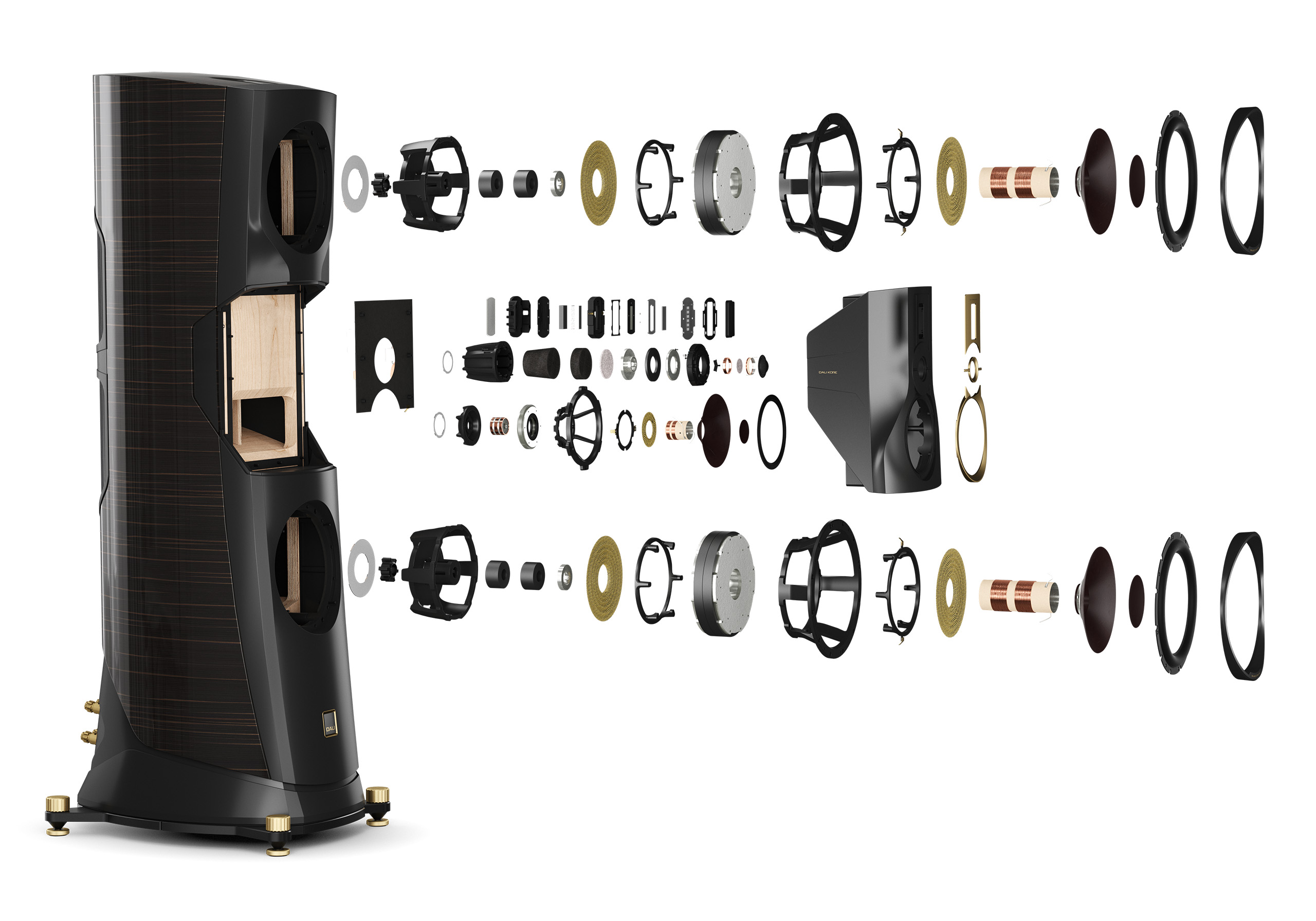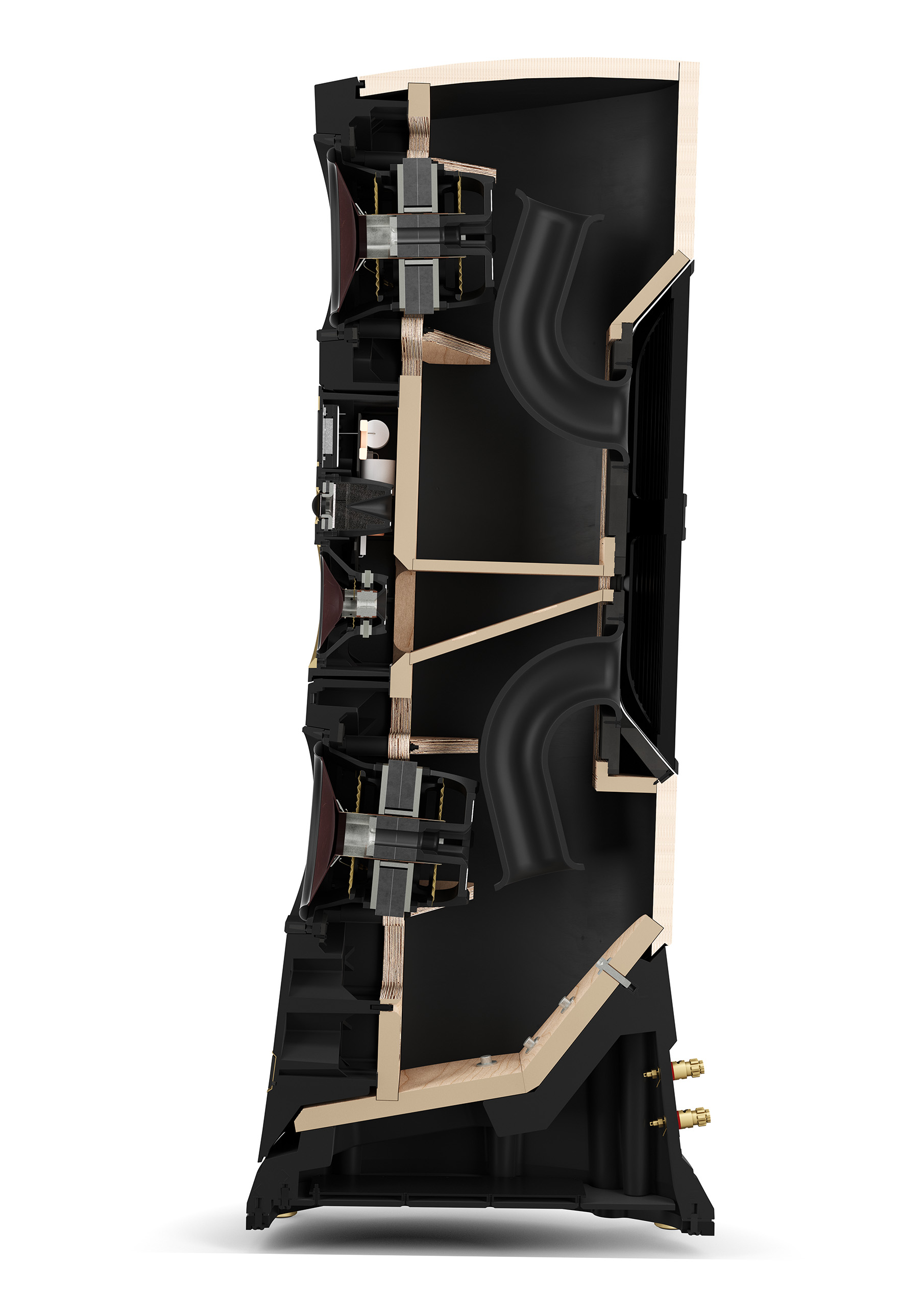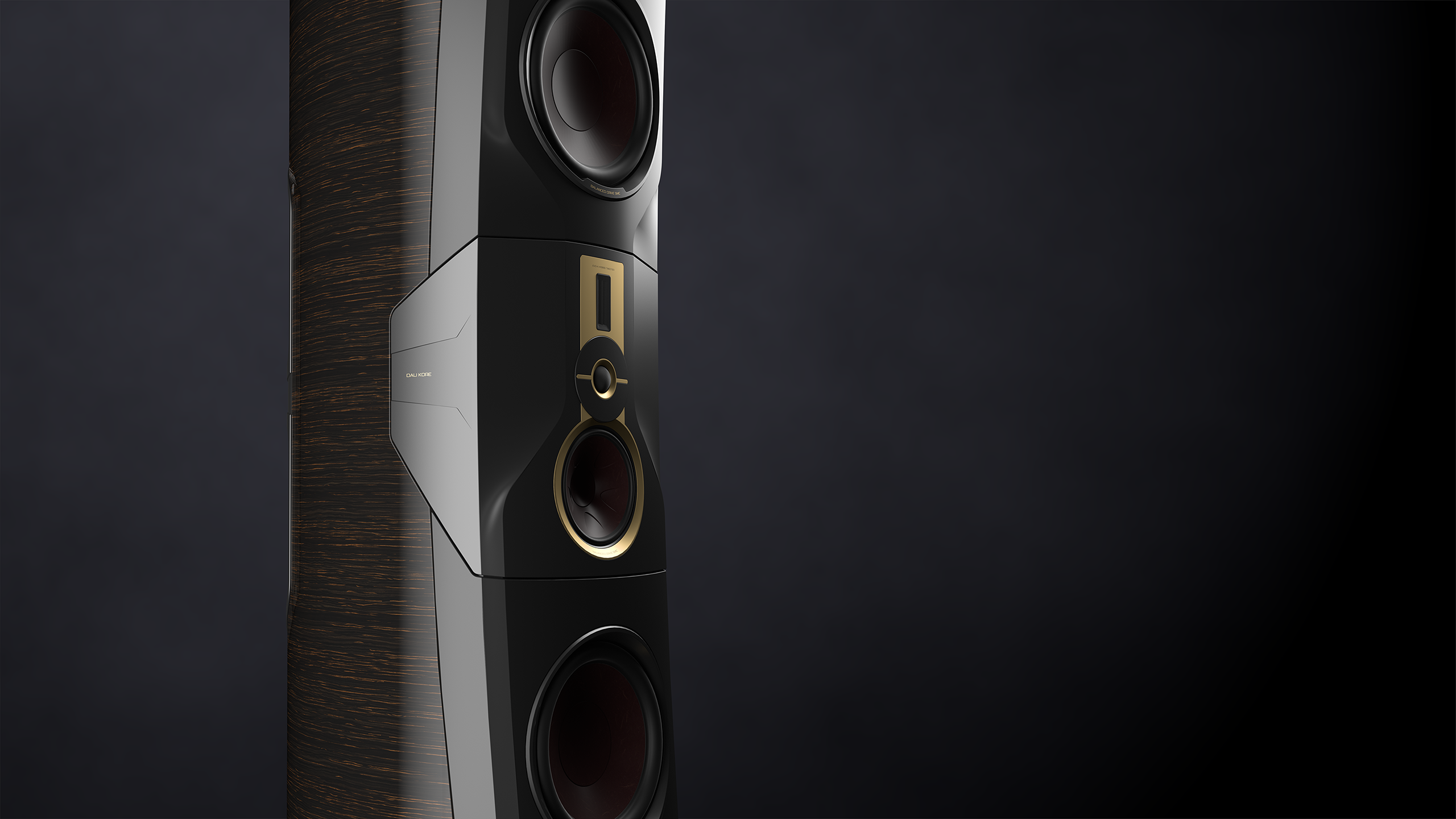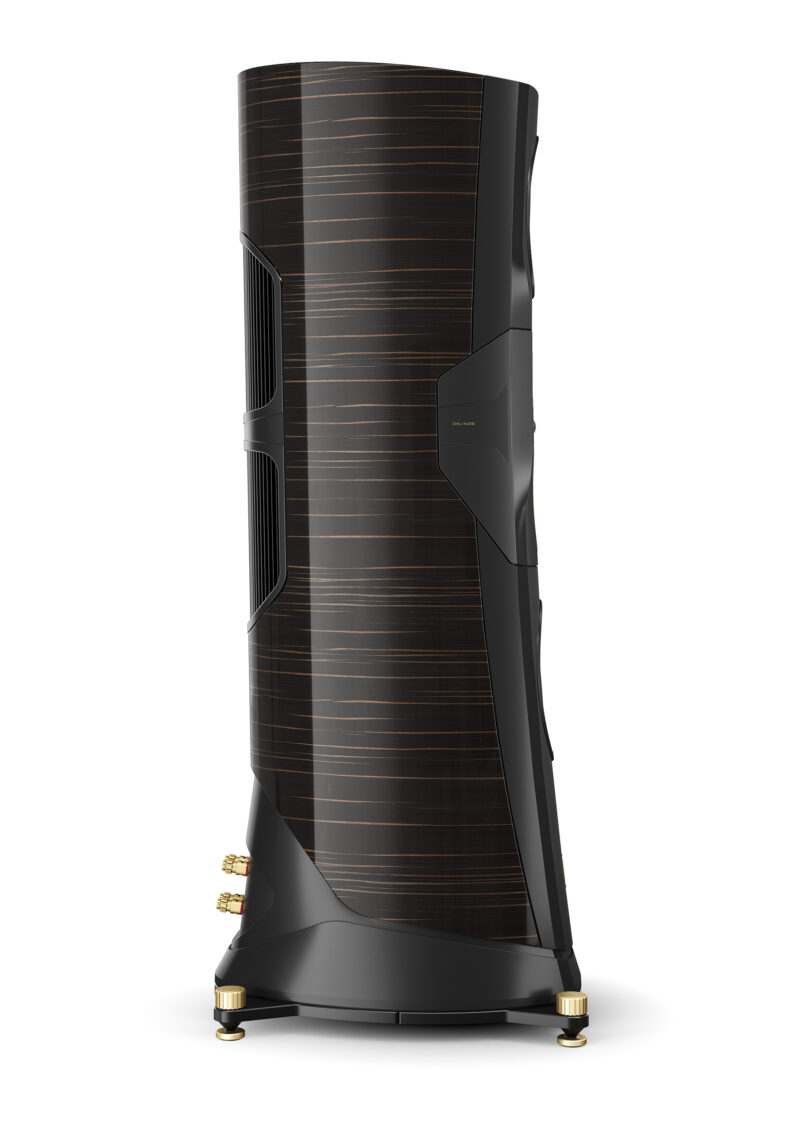Dali Kore is an extraordinary speaker that sounds amazing. It’s as simple as that.
You might argue that it should go without saying that it sounds good when the price of a pair of speakers is on a par with the price of a German luxury car. But to understand how a pair of Dali Kore speakers can cost so much, we have to go back to Munich.
“Kore represents a design, engineering, production and musical rebirth.”
“Kore represents a design, engineering, production and musical rebirth.” This is how Lars Worre put it at the presentation of Dali Kore at the high-end trade fair in Munich in May 2022.
The huge speakers were placed in a room that was far too small, and Dali’s Lars Worre could easily have hidden behind one of them. Instead, he came forward and readily explained that the development of the speakers had taken several years, and that it all started with Lars Worre and his team wanting to see how far Dali could stretch his basic principles without compromising any of them.
In short, if Dali stuck to his own principles of loudspeaker design, they could create a loudspeaker that could go higher, deeper, wider and with much lower distortion than before.
Dali has tried once before. In 2008, they started work on a new model, a flagship that would contain all of Dali’s expertise taken to the most extreme. A prototype was produced three years later and dubbed the Eminent ME9. Unfortunately, due to the world’s financial situation at the time, it was never put into production, but it provided Dali with valuable knowledge that would later come in handy.
The new Dali Kore builds on the ME9, with two woofers – one at the top and one at the bottom – and midrange, tweeter, and ribbon tweeter in the centre of a massive curved-front cabinet. I say massive because the Kore cabinet is nowhere near as slim as the ME9 cabinet, and the speaker weighs close to 150kg.

Dedicated furniture factory
It’s important to emphasise that Dali Kore is in no way a larger version of anything Dali has made before. It’s a unique model that sits at the very top of the hierarchy, and while it has much of Dali’s DNA on the outside and inside, it’s built from the ground up, but of course inspired by the ME9 project from 2011.
The award places Kore in very prestigious company. The Sonus faber Lilium is the elegant Italian challenger, and other comparable speakers are the Maestro Utopia EVO from French Focal and the American Magico M2.
The Kore speakers demand their place in the room, and getting them into position is a challenge. It took three men to get them out of the large boxes they were delivered in. Fortunately, the speakers were fitted with wheels so they could be rolled into place. Once you’ve found the optimal position, you can lower the sturdy feet on the underside to the floor and remove the wheels.
They look great in the room, and the beautiful Ammara veneer extends from the sides and around the curved back of the 167 cm tall, 59 cm deep speakers. Dali bought an old furniture factory to build its own cabinets, and this is where the Kore cabinets come from. They are made from a single piece of 28 mm laminated birch with a 4 mm composite panel, onto which the craftsmen mount the 30 mm thick curved baffle, also made from laminated birch.
4.5-way bass reflex design
Reading the speaker’s white paper is like taking a virtual journey into the minds of Lars Worre and his team. Where the ideas of how the design should work manifest themselves in concrete solutions for diaphragms, suspension, crossovers, damping, right down to the shape of the front baffle and the materials used on the cable terminals.
The two 11.5-inch woofers, as connoisseurs will note, use Dali’s SMC (Soft Magnetic Compound) technology, but they are unique to Kore. The same goes for the new 7-inch midrange driver and Dali’s signature, the familiar EVO-K hybrid tweeter, which consists of a 35mm dome diaphragm and a 10 x 55mm ribbon tweeter.

The woofers are mounted in two identical 72 litre separated chambers with two curved bass reflex ports ending in two openings at the back.
Lars Worre called the crossover a soft crossover because the 390, 2,100 and 12,000 Hz crossover frequencies are softer than normal.
The frequency range is given as 26 Hz – 34 kHz.
SMC units and EVO-K
An unusual speaker naturally has unusual drivers. We’ve already mentioned the EVO-K hybrid, but the woofers deserve some attention too.
But first, the 35mm dome diaphragm in the hybrid tweeter, which doesn’t use oil cooling, both because it’s not necessary, but mainly because the oil dampens the unit’s transient response.

Oil damping would work poorly with the lightweight and lightning-fast ribbon unit, but what about the woofers?
They take far more energy than the tweeters, so they need to be sized to both withstand the impact and not break up when delivering low-frequency energy below 30 Hz.
At the same time, the energy has to exit the loudspeaker and not disappear on the road or drown in cabinet resonances. The two separate internal chambers where the woofers are mounted are damped and reinforced to ensure that the units perform at their best. The unit is built with Dali’s SMC material with two voice coils in an extended magnet gap.
Dali believes this solves a problem common to woofers that have to deliver a lot of energy at low frequencies; it prevents distortion from occurring when the unit is pushed. At the same time, linearity is maintained regardless of sound pressure and bass reproduction becomes even more accurate.
The same goes for the midrange unit, although it doesn’t move nearly as much, let alone as deeply as the woofers. The diaphragms are made as a sandwich of fibre diaphragms on a beehive-shaped core, and the outer layer has an embossed curve that gives the diaphragm better rigidity.
Huge soundscape
Dali’s white paper is far more comprehensive, and for those who want to delve deep into the speaker’s innermost secrets, there’s a very detailed description of the Kore speakers’ technology on Dali’s website.
Because we should instead be talking about the sound of something as enormous and expensive as a pair of Dali Kore. As mentioned, they’re not alone, either in size or price, but there aren’t many speakers in that price range that have as much technically interesting things to talk about as the Kore.
But as everyone knows, it doesn’t matter if the sound coming out of them doesn’t make you go backwards with excitement.
It is of course to be expected that a speaker of this size delivers a soundstage to match, that it delivers realistic sound pressure with ease, and of course that the physical performance, especially in the bass, is in a class of its own. And it is to the highest degree here.
It’s probably the first thing you notice when you turn up the volume – how effortless and light everything seems. Arild Andersen’s double bass has perhaps never been so accurately reproduced. The phrase “it’s as if the musicians are standing in the room in front of you” has rarely been more true.
After manoeuvring the speakers on wheels to find the optimal position in the test room, the wheels were removed and the massive spikes lowered to the floor. This ‘grounded’ the speakers, which delivered a magnificent soundstage, with the double bass getting a tad sharper focus and the balance with percussion significantly improved.
The listed sensitivity of 88dB and the fact that they never go below 3.2 ohms means that you can drive the Kore with a good 50 watt amplifier, but you need to go up to the heavy class to get proper control of the speakers. We used the 300-watt McIntosh MA9500 and the new H30A from Hegel, which can deliver up to 1,100 watts into 8 ohms.
With so much power at your disposal, it’s possible to play at concert volume and imagine you’re sitting in the front row listening to the Arild Andersen Group’s Affirmation. The edge beats on the snare drum slam so hard out of the speakers that you get chills, and each press of the bass drum pedal gives the bass drum a weight behind the beats that you can feel in your stomach.
At the same time, it’s never uncomfortable, because even when you play loudly, nothing sounds harsh or sharp. The music flows effortlessly in space, and I have never heard double bass reproduced better than from Kore.
It’s not just Arild Andersen’s bass that comes through well on a pair of Kore.
The Church of the Nativity in Bethlehem was the setting for a recording made by Kirkeligt Kulturværksted in 1992. The album Rosa from Bethlehem was released as a Christmas album with Sondre Bratland on vocals. Behind him were Paolo Vinaccia on percussion, Knut Reiersrud on guitar and Iver Kleive on keys. The album also featured Suheil Khoury on flute and a Palestinian children’s choir from Ramallah.
The recordings on the album are so atmospheric and sonorous that most loudspeakers can reproduce them, but it takes something special to pick up what’s going on in the street outside. Alf Christian Hvidsteen’s microphones have managed to do just that, even though the recordings were made at night. The Kore speakers bring out tonal nuances, background sounds and details with effortless ease.
At the same time, the lowest notes of the church organ get under your skin, and you’ll never have experienced so much nuance in Bratland’s vocals on any other speaker. They don’t mask anything, but neither do they throw detail into the room with a shovel.
Kore not only delivers a powerful soundscape, they do so with a natural lightness, without colouration or emphasis. Piano sound, for example, is one of the hardest things to reproduce correctly. There’s always something missing. But not here. Quite the contrary. There is more richness, especially in the bottom, and you can hear Jan Gunnar Hoff working with the pedals on the album Home (2L), and not least: How the piano is reproduced with crystal clear sound in a wide and deep soundstage with a pitch black backdrop. With the Hegel H30A, the focus is razor-sharp. The highest piano notes hang weightlessly in front of the speakers, and strings are reproduced with surgical precision.
With the MA9500, the piano and strings sound warmer, and the double bass is fuller, but not as well-defined as with the H30A. If nothing else, Kore demonstrates that amplifiers sound different, and that it matters what you plug into the gold-plated brass terminals on the back.

You can also have a party with Kore. The Hard Way by Khalid and PNAU is 3 minutes and 3 seconds of seductive R&B-pop, and if you put it on at your next party, I can guarantee that the mood will rise. Kore delivers the music with an energy and authority that you can’t help but be infected by. Then when you listen to The Hard Way on a system with speakers other than Kore, you’ll wonder what’s wrong with the sound.
Conclusion
The huge Dali speakers can be accused of being priced to match their size, and I agree that it’s a lot of money, but not that it’s expensive. The alternatives in this price range are few and far between, even if they are very good. What especially speaks in favour of a pair of Dali Kore is how divine the music sounds whether you play it loud or soft, but when you play it loud, you get even more of what’s on the recording. Without it ever sounding distorted or unpleasant. You can always wish for more. A little more airy treble, even deeper bass, or a different cabinet colour for that matter. But you can hardly get a more homogeneous, balanced, open, transparent and detailed speaker than the Dali Kore.

We think
A huge soundstage with endless depth and powerful dynamics. Brings out nuances you've never heard before and sounds great even when playing softly. Effortless and controlled when you play loud. You will need a hefty bank account and a large room.
80000 €
Specifications
- Type: Four-way floorstanding speaker with bass reflex
- Woofer: 2 x 29.2 cm Balanced Drive SMC
- Midrange: 17.8 cm Balanced Drive SMC
- Tweeter: 35 mm dome + 10 x 55 mm ribbon tweeter
- Sensitivity: 88 dB
- Impedance: 4 Ohm (min. 3.2)
- Frequency range: 26 hz – 34 kHz, ± 3 dB
- Crossover frequency: 390 / 2.100 / 12.000 Hz
- Max. load: not stated
- Recommended amplifier power: 50-1,000 W
- Dimensions/weight (cm/kg): 167.5 x 44.8 x 59.3 / 148
- Colours: Lacquered ammara ebony veneer, matte black birch laminate
- Web: dali-speakers.com










